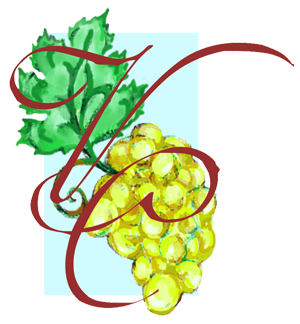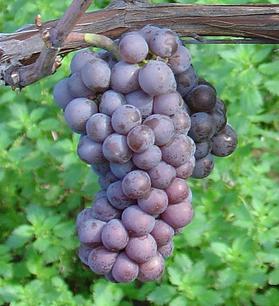Pinot gris or Grauburgunder is a white wine grape variety of the species Vitis vinifera. Thought to be a mutant clone of the Pinot noir variety, it normally has a grayish-blue fruit, accounting for its name (gris meaning "gray" in French) but the grapes can have a brownish pink to black and even white appearance. The word pinot, which comes from the word meaning "pine cone" in French,[1] could have been given to it because the grapes grow in small pine cone-shaped clusters. The wines produced from this grape also vary in color from a deep golden yellow to copper and even a light shade of pink,[2] and it is one of the more popular grapes for orange wine. The clone of Pinot gris grown in Italy is known as Pinot grigio.
Pinot gris is grown around the globe with the "spicy" full-bodied Alsatian and lighter-bodied, more acidic Italian styles being most widely recognized. The Alsatian style, often duplicated in New World wine regions such as Marlborough, Tasmania, South Australia, Washington, and Oregon, tend to have moderate to low acidity, higher alcohol levels and an almost "oily" texture that contributes to the full-bodied nature of the wine. The flavors can range from ripe tropical fruit notes of melon and mango to some botrytis-influenced flavors. In Italy, Pinot grigio grapes are often harvested early to retain the refreshing acidity and minimize some of the overt-fruitiness of the variety, creating a more neutral flavor profile. This style is often imitated in other Old World wine regions, such as Germany where the grape is known as Ruländer.[3]
Viticulture
The grape grows best in cool climates, and matures relatively early with high sugar levels. This can lead to either a sweeter wine, or, if fermented to dryness, a wine high in alcohol. Clusters of Pinot gris may have a variety of colors in the vine. These clusters can range from bluish grey to light pinkish brown.[33] The grapes grow in small clusters (hence the pinecone name), and upon ripening, often display a pinkish-gray hue, although the colors can vary from blue-gray to pinkish-brown. Pinot gris is often blended with Pinot noir to enrich and lighten the Pinot noir's flavor.[35]
Wines made from the Pinot gris vary greatly and are dependent on the region and wine making style they are from. Alsatian Pinot gris are medium to full bodied wines with a rich, somewhat floral bouquet. They tend to be spicy in comparisons with other Pinot gris. While most Pinot gris are meant to be consumed early, Alsatian Pinot gris can age well.[36] German Pinot gris are more full-bodied with a balance of acidity and slight sweetness. In Oregon the wines are medium bodied with a yellow to copper-pink color and aromas of pear, apple, and/or melon. In California, the Pinot gris are more light bodied with a crisp, refreshing taste with some pepper and arugula notes. The Pinot grigio style of Italy is a light-bodied, often lean wine that is light in color with sometimes spritzy flavors that can be crisp and acidic.[37]
Pinot gris is considered an "early to market wine" that can be bottled and out on the market within 4–12 weeks after fermentation.[38]




